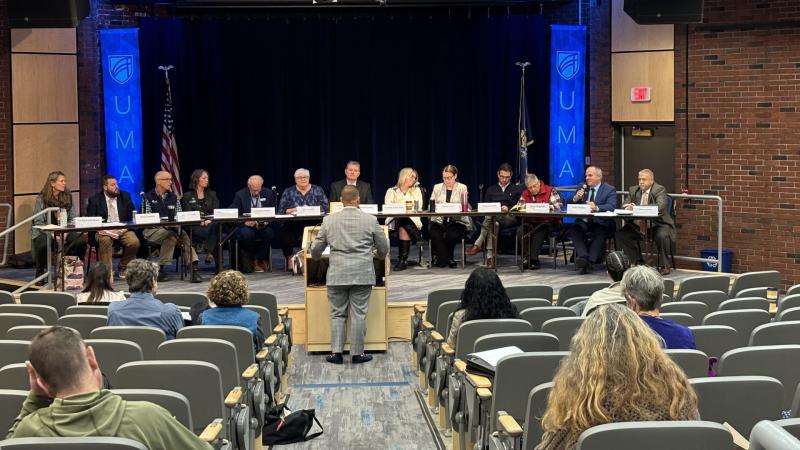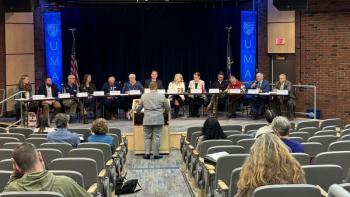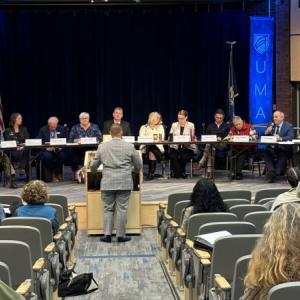Counties and municipalities have spent about $7 million of their opioid settlement funds so far
The counties and municipalities that receive a direct share of the settlement funds from opioid manufacturers, distributors and retailers have spent less than half of the money paid out so far, a Maine Monitor survey found.
Since payments began three years ago, the counties and municipalities have received about $20.3 million out of the $66.4 million they’re set to receive by 2038. The money has been used for a wide range of initiatives, from grants to community organizations providing recovery services to scholarships for residential treatment beds.
Over the past five years, nationwide settlements were reached with 10 pharmaceutical companies accused of fueling the opioid crisis as the result of a years-long, massive multidistrict litigation case. The settlements, with household names like Johnson & Johnson and Walgreens, will pay out billions of dollars over 18 years, approximately $230 million of which will go to Maine.
Maine’s share is split in three ways, including 30 percent divided up among the “direct share subdivisions” — the 39 counties, cities and towns that were either party to the multidistrict litigation case and/or have a population of at least 10,000. (The percentage each subdivision receives is determined by the settlement agreements.) That includes all 16 counties, the 21 largest municipalities, Rockland and Calais.
Fifty percent of Maine’s share goes to the Maine Recovery Fund overseen by the 15-member Maine Recovery Council and the remaining 20 percent goes to the state and is overseen by the attorney general’s office, per the state’s memoranda of understanding.
The settlement agreements say that the money must be used for “opioid abatement” and lay out a long but fairly open-ended list of approved uses. Oversight is scant, however: outside of public access laws, subdivisions are under no obligation to publicly report how they are spending their money. And the trusts themselves have limited oversight power.
While subdivisions can spend up to 15 percent of their funds on “non-opioid remediation,” disclosure is all self-reported to the trusts. As of early May, no subdivisions in Maine had reported any spending on non-opioid remediation.
As part of ongoing efforts to shed light on how the millions from these landmark settlements are being spent, The Monitor has sent three surveys to the subdivisions since 2023. Thirty subdivisions responded to The Monitor’s latest survey from mid-March on how they are spending their funds.
Results show that spending for programs within county jails, sheriff’s offices and police departments remains a popular choice. Ten counties have used nearly a third of all funds expended so far to help pay for medication-assisted treatment, counseling services and other costs related to substance use treatment in jails.
At least seven counties and municipalities have put the funds toward hiring mental health liaisons to work directly with law enforcement. Several others used the funds to purchase equipment for police departments, including Saco and Falmouth, both of which bought handheld drug-checking devices, and Lewiston, which purchased a vehicle for its mental health worker ride-along program.
Ten subdivisions used at least some of their funds to provide grants to local organizations working on substance use response. Cumberland County, for example, put out a request last year for proposals that “support treatment innovations and capacity building projects.”
Greater Portland Health’s proposal to launch a mobile medical van to conduct outreach among populations most at risk of overdose, including people experiencing homelessness and those recently released from the Cumberland County jail, was selected among nine proposals, according to public health director Liz Blackwell-Moore.
The only subdivision that has spent all of the money it has received so far, about $1.4 million, is York County, which decided early on to allocate all of its funds to build a new regional recovery center in Alfred.
In mid-March, The Monitor sent administrators from all of the subdivisions a survey asking how much money has been spent or allocated so far and the process for determining how the funds are spent. Using those responses — together with data compiled from two previous Monitor surveys conducted last spring and summer of 2023 — The Monitor created a database of estimated spending so far.
Each subdivision has responded to at least one survey, with the exception of Waterville. Gorham, Lewiston, Oxford County, Piscataquis County, Sanford, South Portland, Wells and York did not respond to the Monitor’s March survey, so data from the most recent survey they responded to was used. For all except Sanford, that was April 2024. Sanford last responded to The Monitor’s June 2023 survey.
Administrators from six subdivisions — Auburn, Calais, Kennebunk, Orono, Oxford County and Wells — said they have not spent any money yet, leaving nearly $1.6 million untouched. (Standish signed an agreement with Cumberland County to provide its entire estimated $44,100 payout to the county.)
This story was originally published by The Maine Monitor, a nonprofit civic news organization. To get regular coverage from The Monitor, sign up for a free Monitor newsletter here.
























